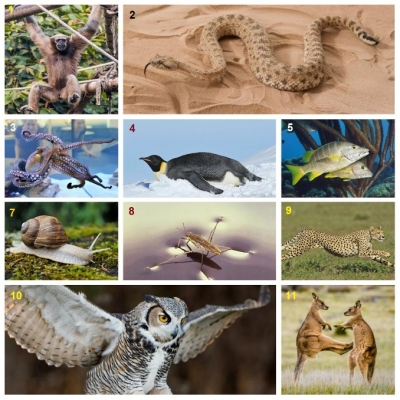
MOVEMENT
The feature that makes animals so different from other living things is their ability to move. Some do not move much – a sea anemone, for example, is sedentary (remains in one place) and catches anything that touches its tentacles. Most animals, however, travel to look for food, find breeding partners, or escape from their enemies. They slither, crawl, walk, hop, run, swim, and fly, sometimes at incredible speed. Some have evolved other amazing ways of getting about, like the insects and spiders that walk on water, and the extraordinary side-winding rattlesnakes.
- GIBBON Although gibbons can walk well, they usually move through the forest by using their long, powerful arms to swing from the trees. They hurl themselves from branch to branch with astonishing speed, agility, and elegance.
- SNAKE A typical snake slips along by curving its flexible body around plants and stones, and pushing the curves towards its tail. Sidewinders like the desert viper have a more baffling method, looping sideways over the sand like rolling springs.
- OCTOPUS An octopus normally hauls itself over the seabed using its long, elastic arms. But it can shoot away from danger by jet propulsion, drawing water into its body and blasting it out at high pressure. Cuttlefish and squid do the same.
- PENGUIN All penguins are superb swimmers, using their wings to “fly” through the water, but they walk clumsily. On snowy slopes they often prefer to toboggan on their well-padded bellies, pushing themselves along with their stoutly clawed feet.
- FISH Most fish have flexible bodies that allow them to move through the water using their fins for stability and to control their direction. Some fish, such as tunas, propel themselves at high speed using just their tails.
- STARFISH A starfish can curl its arms, but it actually creeps over the seabed using hundreds of tiny “tube feet” on its underside. Each tube foot is pumped full of water, and is extended and moved by changes in water pressure.
- SNAIL The muscles in a snail’s foot contract and expand to create a rippling movement that pushes the snail forward. Glands in the foot produce slimy mucus to make the track slippery. The slime also protects the snail from debris.
- POND SKATER The water molecules at the surface of a pool cling together to form an elastic film, strong enough to support tiny animals like pond skater. Its special brush-tipped feet just dimple the surface, so it can skate around without sinking.
- CHEETAH The fastest of all land animals, a cheetah can run at an astonishing 95 km/h (60 mph). It achieves this by flexing its back to extend its stride as it bounds forward on its long legs, but it can only keep up this pace for about 40 seconds.
- BARN OWL Birds are the masters of the air. Most, like the barn owl, use their powerful feathered wings to drive themselves forward. Others can travel long distances by soaring on rising air currents like gliders, without beating their wings at all.
- KANGAROO A leaping kangaroo uses the elastic tendons in the backs of its legs like the springs of a pogo stick. Every time it lands on its long feet the tendons stretch like rubber bands, then spring back again to catapult the kangaroo forward.
Picture Credit : Google




